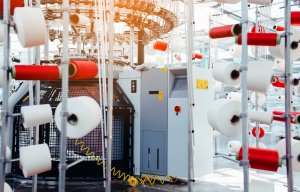
Tracing production costs in the primary textile industry
As part of its campaign to localise British manufacturing, Derbyshire fashion firm David Nieper has commissioned an academic report.

10th October 2019
Knitting Industry
|
Alfreton

Dressmakers at David Nieper Sewing Rooms, Derbyshire. © David Nieper
As part of its campaign to localise British manufacturing, Derbyshire fashion firm David Nieper has commissioned an academic report into the environmental impact of offshore manufacturing.
The report which was conducted by the University of Nottingham Energy Innovation and Collaboration team, has revealed the practice of offshoring manufacturing essentially amounts to offshoring pollution, with two-thirds of emissions from UK clothing occurring overseas.
The report also highlights 47% less emissions are created by manufacturing clothes in the UK, in comparison to a similar operation in an overseas textiles production base. “The trend to manufacture overseas has not only decimated the jobs in British fashion but is having a disastrous effect on the planet,” commented Christopher Nieper, Managing Director, David Nieper. “We commissioned this report to highlight the environmental benefits of manufacturing closer to home. As an industry we can become more sustainable by removing at least some of these journeys to help make production process gentler on the environment.”
The University’s report studied the energy and greenhouse gas emissions for the manufacturing operations of David Nieper, which designs and makes clothes in the UK and sells online and through catalogues, as opposed to a garment retailer that manufactures overseas and sells on the British high street.

Citarum River, Indonesia – featured in Stacey Dooley’s BBC documentary, Fashion’s Dirty Secret. The environmental destruction of the Citarum River is attributed to local clothing factories, which are linked to large high street fashion chains in the UK. © David Nieper
Renewable energy plays a key part in keeping energy consumption to a minimum. Within the garment production process, the sewing phase typically requires most energy consumption. David Nieper’s solar panels, energy efficient machinery and LED lighting means the average power required to make each garment has been reduced by 37.5%, dropping from 8.03kWh to 5.16kWh per garment.
The report also shows the biggest contributing factor to cleaner and more efficient manufacturing in the UK, is due to the lower carbon intensity of electricity supply network. The UK has significantly lower carbon emissions per unit of electricity compared to overseas production hubs such as China, Bangladesh and Turkey; therefore production in the UK has lower direct carbon emissions – making it a more sustainable manufacturing base.
For example, according to the report, a manufacturer in China would typically release around 90% more greenhouse gas emissions (GHG) while using the same energy as in the UK; Turkey would release around 70% more GHG emissions than using the same energy as the same in the UK and Bangladesh uses 24% more – ultimately making UK production more environmentally viable.
The long distance transportation of goods and component parts, which has become synonymous with the textiles industry, is cited as another environmentally damaging practice and significant contributor to GHG.

David Nieper’s luxury knitwear includes merino jumpers and cashmere knits. © David Nieper
According to the recent House of Commons Environmental Audit Committee’s Fixing Fashion report, the fashion and textiles industry produces an estimated 1.2 billion tonnes of CO2 equivalent per year – more than international flights and the maritime trade combined.
The University of Nottingham report details shipping distances to the UK high street from the three biggest textiles manufacturing centres range from 6,226km from Turkey, 16,123km from Bangladesh and 21,694km from China. Air freight is the worst polluter in the distribution stage, contributing 90% of greenhouse gas emissions.
“It stands to reason that sourcing offshore incurs thousands of air miles per garment and environmental standards are not the same in all countries. British retailers need to consider their entire supply chain and take more responsibility. Our report has shown that more than two-thirds of the emissions from UK clothing consumption occur in other countries,” said Mr Nieper.
“Offshoring manufacturing is offshoring pollution - it’s not acceptable to shift the problem overseas, where it’s out of sight and out of mind.”
David Nieper has been a designer and manufacturer of fashion for ladies aged 50+ for almost 60 years. The company has a zero waste to landfill status and operates a just-in-time manufacturing policy to eliminate waste. A few years ago, it invested in a plant of Shima Seiki machines to form an in-house knitwear division and manufacture its own knitwear.

Business intelligence for the fibre, textiles and apparel industries: technologies, innovations, markets, investments, trade policy, sourcing, strategy...
Find out more